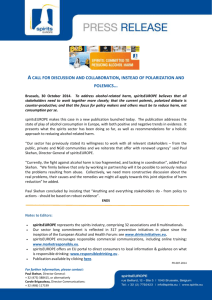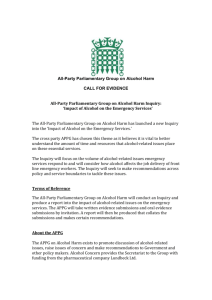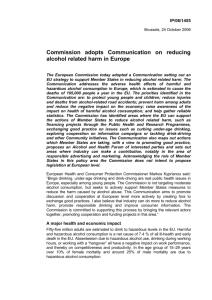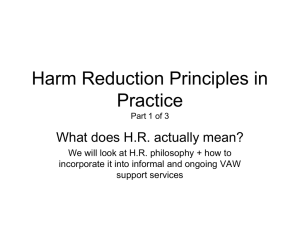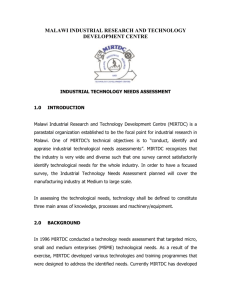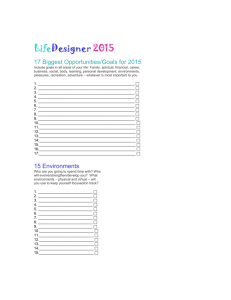National Alcohol Policy Final Draft, Part II
advertisement
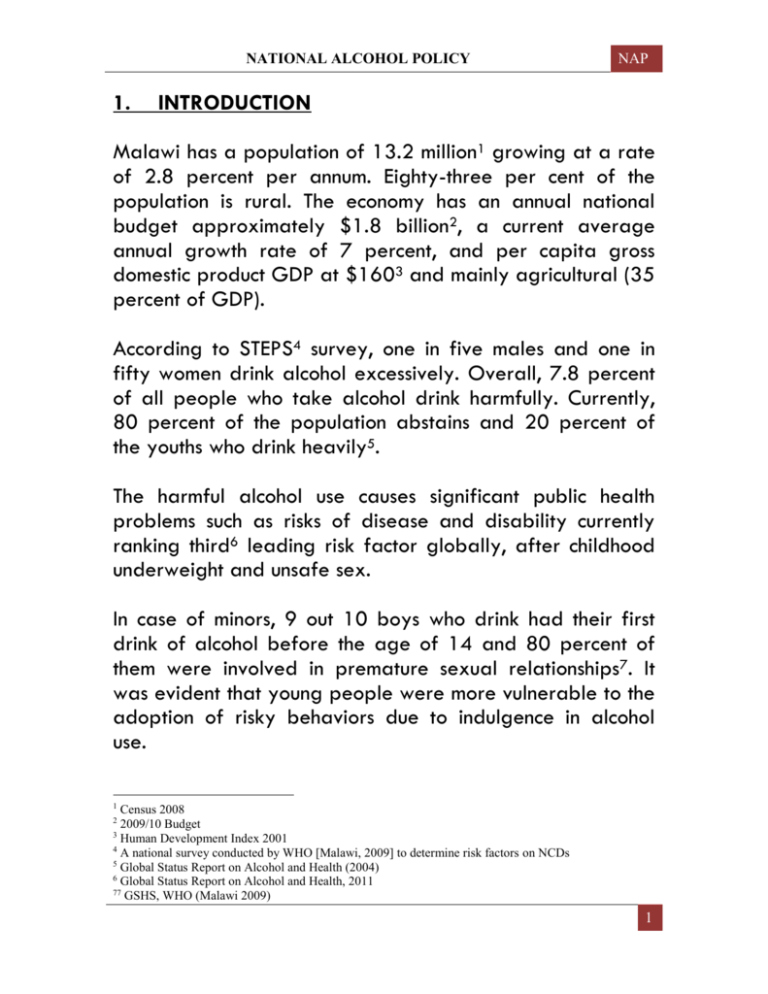
NATIONAL ALCOHOL POLICY 1. NAP INTRODUCTION Malawi has a population of 13.2 million1 growing at a rate of 2.8 percent per annum. Eighty-three per cent of the population is rural. The economy has an annual national budget approximately $1.8 billion2, a current average annual growth rate of 7 percent, and per capita gross domestic product GDP at $1603 and mainly agricultural (35 percent of GDP). According to STEPS4 survey, one in five males and one in fifty women drink alcohol excessively. Overall, 7.8 percent of all people who take alcohol drink harmfully. Currently, 80 percent of the population abstains and 20 percent of the youths who drink heavily5. The harmful alcohol use causes significant public health problems such as risks of disease and disability currently ranking third6 leading risk factor globally, after childhood underweight and unsafe sex. In case of minors, 9 out 10 boys who drink had their first drink of alcohol before the age of 14 and 80 percent of them were involved in premature sexual relationships7. It was evident that young people were more vulnerable to the adoption of risky behaviors due to indulgence in alcohol use. 1 Census 2008 2009/10 Budget 3 Human Development Index 2001 4 A national survey conducted by WHO [Malawi, 2009] to determine risk factors on NCDs 5 Global Status Report on Alcohol and Health (2004) 6 Global Status Report on Alcohol and Health, 2011 77 GSHS, WHO (Malawi 2009) 2 1 NATIONAL ALCOHOL POLICY NAP The Policy prioritizes behavior change through prevention programmes for the abstention target group through elaborate education programmes. 1.2 Rationale The Government of Malawi has since 1979 enacted several legislations8 targeting various alcohol-related offences towards reducing the impact of alcohol-related harms. Nevertheless, most of the provisions are either outdated, disjointed, not effectively enforced and/or fall short of international standards. The Policy shall provide comprehensive strategies for developing, implementing, coordinating, monitoring and evaluating health-related interventions from alcohol related harm. The rationale is founded on the belief that a comprehensive national alcohol policy shall: 1.2.1 Identify the effects of alcohol-related harm across public health, social, economic terms; 1.2.2 Identify the key target groups affected by alcohol-related harm in terms of alcohol consumption patterns; 1.2.3 Identify key stakeholders for developing, implementing, coordinating, monitoring and evaluating 8 Liquor, Road Traffic, Taxation, and Consumer Protection Acts 2 NATIONAL ALCOHOL POLICY NAP health-related intervention deriving from alcohol related harm; 1.2.4 Contribute to national development through reducing the pressure exerted on resources by social and health problems; 1.2.5 Provide the framework for addressing harmful use of alcohol; 1.2.6 Clearly define programming parameters such as scope of strategies, interventions, targeting in respect of the overall goal of the policy; 1.2.7 Develop tailor-made target-specific responses and interventions for reducing alcohol-related harm; 1.2.8 Define the relationship between alcohol and poverty, HIV and AIDS, and Non Communicable Diseases; 1.2.9 Outline the alcohol-related impacts at individual, family, community, national levels; 1.2.10 Draw out the legal framework for control of alcohol-related harms; 1.2.11 Provide a framework for the promotion, protection and fulfillment of human rights in view of alcohol-related harm; 3 NATIONAL ALCOHOL POLICY NAP 1.2.12 Provide support for developing adequate treatment and rehabilitation9 services for those affected by alcohol-related harm such as disease, injury, disability, social problems; 1.2.13 Provide mechanisms for capturing data for recorded and unrecorded alcohol production and consumption. 1.2.1 Problem Statement The objects of the existing laws10 do not reflect the purpose of promoting public health outcomes. The major problem is the significance of public health and socio-economic harms. The intent of this Policy, therefore, is to promote the public health goals. 1.2.2 Purpose The Policy shall support public health and socio-economic strategies in reducing harmful use of alcohol. In particular, the Policy aims at providing and setting guidance within the specific public health and socioeconomic priority areas for action at community and national levels. 9 Treatment, therapy, remedy, cure, etc Road Traffic, Consumer Protection, Liquor Licensing and Taxation Acts 10 4 NATIONAL ALCOHOL POLICY NAP 1.3 Linkages with Other Relevant Policies In particular, the Policy links with the Public Health Act, which embraces prevention and control of communicable and noncommunicable diseases, injuries and mental health. 1.4 Key Challenges The Policy challenges: 1.4.1 envisages the following implementation Institutional In respect of roles, functions and powers, the Policy anticipates challenges in coordination, management, implementation and monitoring of alcohol programmes. The Policy shall provide legal authority for formally empowering relevant institutions to subject accountability and liabilities against harmful use of alcohol. The Policy, therefore, recognizes the institutional multisectoral roles and responsibilities spreading across the different ministries. 1.4.2 Political Will and Public Support The Policy shall recognize that implementation hinges on the political commitment as well as the support of the general public. 5 NATIONAL ALCOHOL POLICY NAP The Policy, therefore, shall call for the institutionalization of alcohol programmes for ensuring sustainable Government and public support. 1.4.3 Human Resource and Management The Policy recognizes that there are limited personnel for prevention, management and control of alcohol-related cases. The Policy, therefore, shall promote capacity building and partner cooperation with the existing players at national including primary healthcare, regional and international level for lessons, experiences, best practices, models and information resources. 1.4.4 Financing The delivery of alcohol programmes shall require the commitment of financial and technical resources for achieving the intended goals of the Policy. The Policy, therefore, recognizes that Malawi Government, through Parliament, shall identify with the consequences of alcohol-related burdens such as public health, social and economic costs. The Policy also recognizes the support from the development partners to assist in the provision of resources. 1.4.5 Behavioral 6 NATIONAL ALCOHOL POLICY NAP The Policy recognizes the differences in drinking patterns according to age, sex, culture, type of alcohol and income distributions. The Policy desires positive change in behavior patterns through health promotion interventions. 1.4.6 Influence from the Alcohol Industry The Policy recognizes exertion of influence on policy decisions through their corporate responsibility of tax remittances. The Policy shall urge restraint through collective responsibility in interacting with the Alcohol Industry. 1.5 Alcohol and the existing Laws The Policy recognizes the existing laws contained in the Liquor Licensing, Taxation, Road Traffic and Consumer Protection Acts. The Policy shall set out a comprehensive implementation mechanism for ensuring efficient and effective enforcement, prevention, advocacy campaigns, treatment, monitoring mechanisms for the achievement of the objects of reducing alcohol-related harms. 1.6 Impact of Alcohol Supply and Use 1.6.1 Positive Impact 7 NATIONAL ALCOHOL POLICY NAP The Policy duly recognizes the important role that alcohol production, distribution and sales play in securing public revenues through taxes and personal incomes as well as employment. 1.6.2 Negative Consequences The Policy also considers the public health development11 burdens from harmful use of alcohol. 1.6.2.1 and Alcohol and Public Health Costs 1.6.2.1.1 Communicable Diseases The Policy primarily identifies HIV and AIDS as a communicable disease whose casual relationship with harmful alcohol use poses greater risks worth intervening. In particular, studies show key patterns of interaction between alcohol use and sexual behavior, therefore, poses greater risks of STIs and/or HIV infection12. In many respects, alcohol use is linked to increased incidences of sexual behavior. Similarly, harmful alcohol use is also associated with the increased weakening of the immune system leading to further defenselessness to and development of HIV and AIDS respectively. 11 12 Socio-economic Alcohol Use and Sexual Behavior: A Cross-Cultural Study in Eight Countries (WHO, 2009) 8 NATIONAL ALCOHOL POLICY NAP For the infected persons, harmful alcohol use on the one hand and AIDS and TB conditions on the other undermine efforts to addressing medical complications such as inconsistent adherence and delayed treatment. 1.6.2.1.2 Non-Communicable Diseases (NCDs) The Policy recognizes the burden of disease exerted by harmful alcohol use particularly on non-communicable diseases such as cancer, diabetes, liver and heart disorders, chronic respiratory diseases, violence, trauma and injuries and mental illnesses. The Policy recognizes three major alcohol-related public health conditions namely toxicity, intoxication and dependence that lead to burdens of disease, injury and deaths. In particular, intoxication makes individual drinkers vulnerable to a range of risk-taking behaviors such as indulgence in unsafe sex, violence, suicides and injuries. The dependence-producing properties of alcohol consumption manifest as either stimulants or depressants, resulting in excitation, withdraw and anxiety behaviors, which is a cause for concern in public health perspectives. Similarly, alcohol is a toxic substance that exerts different body organs disorders and disability as well as injuries and death tolls. 1.6.2.1 Alcohol and Development Costs 9 NATIONAL ALCOHOL POLICY NAP Harmful use of alcohol is considered both a cause and consequence of social and economic harms at individual, family, community and national levels. In essence, harmful alcohol use not only takes away the required human resource through the associated alcoholrelated harms but also exerts disproportionate costs on prevention, enforcement, treatment services that would otherwise be avoided. The main social harms include gender-based violence, family disruptions, and diminished incomes through diversions, commission of crimes, youth delinquencies, addictions, child neglect, abuse and exploitation. Similarly, significant economic harms comprise work-related problems due to absenteeism and underperformance leading to unemployment, homelessness and reduced workplace productivity. The Policy shall recognize that costs borne out of public health and socio-economic burdens collectively translate into enormous development expenses. 2. BROAD POLICY DIRECTIONS The Policy strategic direction shall be reducing harmful use of alcohol. 2.1 Vision To create a society free of alcohol-related harms. 10 NATIONAL ALCOHOL POLICY NAP 2.2 Mission To promote public health and socio-economic conditions by reducing harmful use of alcohol for the improved well-being of Malawians. 2.3 Overall Objective of Policy The overall policy objective is reducing harmful use of alcohol. 2.4 Principles The Policy shall be guided by the following principles: 2.4.1 Needs and Evidence-Based The Policy shall address the needs of the target groups based on the evidence and analysis of data and information products through monitoring and evaluation; 2.4.2 Non-participation of economic stakeholder The collaboration13 with economic stakeholders shall be during implementation and NOT the development and review of policy. 2.4.3 Prevention and Protection The Policy shall prioritize prevention and protection interventions other than those that require treatment responses; 13 Recommendation by WHO 11 NATIONAL ALCOHOL POLICY NAP 2.4.4 Partnership & Cooperation The Policy recognizes the multi-sectoral approach towards addressing harmful use of alcohol. 2.4.5 Rights-Based The Policy shall promote and protect the interests of the vulnerable groups from alcohol-related harm. 2.4.6 Governance The Policy shall promote a clear management framework at community and national levels. 2.5 Objective(s) of the Policy The specific objective(s) of the Policy is reducing alcohol consumption. 3. POLICY THEMES In general, the dynamics of alcohol is basically the supply and demand function; therefore, the response system towards reducing alcohol-related problems must seek to address such parameters. The Policy, therefore, prioritizes regulation (availability and accessibility) and prevention (acceptability and affordability) responses towards reducing alcohol-related harm. Policy Area 1: Supply of alcohol products 12 NATIONAL ALCOHOL POLICY NAP The supply function of alcohol refers to the availability (production) and accessibility (distribution and sale) of such alcohol-related products. In particular, availability means the production system through formal14 and informal 15mechanisms and the accessibility of alcohol products refers to the distribution and sales systems. The alcohol products are made available through production, whether communally-produced or consumerbranded produced. The alcohol products, therefore, can be identified as follows: homecraft, local-industrial, local-industrial production of cosmopolitan alcohol beverages and globalized-industrial production of cosmopolitan alcoholic beverages like brandy, whisky and vodka. The Policy realizes that there are homecraft production and shall recognize them after being tested and certified safe by regulatory bodies. The Policy, therefore, shall set the scope for national and community action in guiding the homecraft production through organization, mobilization, monitoring and control measures. Objective To ensure reduced harmful use of alcohol 14 15 Legally sanctioned by tax and illegally availed through border smuggle Locally untaxed brews 13 NATIONAL ALCOHOL POLICY NAP Priority Area 1 To provide for availability and accessibility systems through limitations Strategies (i) (ii) Provide producer-license for alcohol products; Local authorities shall regulate the number of retail outlets per locality; (iii) Enforce minimum purchase and consumption age; (iv) Limit by time and hours for opening and closing of outlets; (v) Limit areas by density and location of outlets; (vi) Limit public drinking; (vii) Ban on liquor sachets (viii) Classify retail outlets as bottlestores, night clubs, bars and shops for license and time administration; (ix) Restrict community-based and urban-based selling premises; (x) Restrict community-based brewing to a reasonable number of premises in the traditional authority as decided by local councils; (xi) Empower community policing forums to monitor supply of alcohol products from the designated premises; (xii) Register communal brewers through associations/cooperatives at traditional authority level; (xiii) Empower local councils through traditional authorities to levy community brews; (xiv) Assure and monitor minimum standards of communal brews to screen off harmful ingredients16 from the designated points; (xv) Promote business alternatives for local brewers; 16 Drugs such as chamba, ARVs, fertilizers 14 NATIONAL ALCOHOL POLICY NAP Priority Area 2 Develop capacity for alcohol law enforcement agencies such as the Police, Road Traffic Directorate, Courts, Local Authorities, Malawi Bureau of Standards, Malawi Revenue Authority (i) (ii) Strengthen institutional capacities of the existing law enforcement, implementation and monitoring agencies; and Administer the existing and new regulations on production, distribution and sales of alcohol products; Policy Area 2: Demand for alcohol products Objective To reduce the demand for alcohol products through behavior change interventions Priority Area 1 To promote formal education and training Strategies (i) Provide for school-based curriculum interventions such as life skills education; (ii) Develop workplace alcohol policy for employees; (iii) Provide for formal work-place education sessions for employees; Priority Area 2 To promote informal education (civic education/community action campaigns) Strategies 15 NATIONAL ALCOHOL POLICY (i) (ii) (iii) (iv) (v) (vi) (vii) (viii) (ix) (x) NAP Encourage public awareness campaigns on health, social and economic problems caused by harmful use of alcohol; Develop information, knowledge and skills products on the magnitude of alcohol-related harm for effective interventions; Mobilize community groups for promoting greater leadership for increased coordination of and partnership in alcohol-related programmes; Engage advocacy on alcohol-related harms by civil society; Strengthen the capacity of existing research institutions for designing and implementing measures that target problems that arise over time on alcohol-related harm; Develop capacity of facilitators of alcohol-related harm reduction programmes; Develop and disseminate public education messages on the Policy and legislation provisions to community groups through print and electronic media; Promote decentralization of harmful alcohol use prevention through local authorities; Enforce alcohol no-drink rule by workers during working hours; Provide for the National Day of No Harmful Use of Alcohol; Priority Area 3 To regulate marketing of alcohol products by the alcohol industry Strategies 16 NATIONAL ALCOHOL POLICY NAP (i) Limit alcohol advertising by content of messages and volume per a given period through product placement on radio, TV and internet through e-mails and mobile phones particularly targeting young ones; (ii) Limit sponsorships for cultural or sports events as well as promotional competitions of alcohol products; (iii) Set deterrence systems for infringements on marketing restrictions; (iv) All alcoholic beverages must carry health warning labels; Priority Area 4 To promote research on trends in consumption patterns and their impact on public health outcomes Strategies (i) (ii) Ensure evidence-based research on the impact of alcohol responses; Ensure surveillance on consumption, consequences and responses; Priority Area 5 To set higher minimum prices for alcohol products Strategies (i) Increase taxes by percentage volume of alcohol; Priority Area 6 To reduce drink-driving cases of injury and deaths 17 NATIONAL ALCOHOL POLICY NAP Strategies (i) Reduce and enforce a legal blood alcohol concentration BAC limit from 0.8g/L to 0.5g/L for driving through random breath tests; (ii) Establish sobriety checkpoints for regular breath testing of drivers; (iii) Provide for on-the-spot fines with incremented severity per subsequent offence annually such as driving license seizures, suspensions, revokes; (iv) Develop a record system that catch repeat drink-drive offenders; (v) Enforce mandatory fines for funding/sponsorship for anti-public health alcohol programmes; Priority Area 7 To promote the public health services’ response through prevention and treatment Policy Strategies (i) Develop capacity of primary health care system17 for delivery of prevention and treatment for alcoholattributable conditions; (ii) Provide rehabilitation services such as counseling to sufferers of alcohol harm; (iii) Establish and maintain a registration and monitoring system of alcohol-attributable burdens such as disease, injury and deaths for effective reporting; (iv) Provide specialist training for treatment of alcohol disorders; 17 WHO_ASSIST and WHO_PEN 18 NATIONAL ALCOHOL POLICY 4. NAP IMPLEMENTATION ARRANGEMENTS 4.1 Institutional Arrangements 4.1.1 NCDs) Inter-Ministerial Committee on NCDs (IMC- 1. There shall be the Inter-Ministerial Committee on NonCommunicable Diseases with overall oversight leadership, coordination and follow-up of the Policy strategies and activities led by the Ministry of Health; 2. The membership of the Committee shall be as follows: Secretary for Health (Chairperson); Secretary for Home Affairs and National Defence; Secretary for Education; Secretary for Local Government; Secretary for Youth; Secretary for Trade; Secretary for Information; Roles, Functions and Powers of IMC-NCDs 1. IMC-NCDs shall provide policy direction and oversight for the implementation of the Policy; 2. IMC-NCDs shall responsibility; 4.1.2 provide overall Non-Communicable Diseases illnesses---Ministry of Health coordination & Mental 19 NATIONAL ALCOHOL POLICY NAP 1. There shall be the Sub-Technical Working Group (TWG) on alcohol harm reduction responsible for the technical direction and programme implementation; 2. The membership of the TWG shall be as follows: Director for Clinical Services (Health) (Chairperson); Director for Preventive Health Services (Health); Director for Non-Communicable Diseases (Health); Director for Home Affairs and National Defence; Director for Education; Director for Nutrition, HIV and AIDS; Director for Local Government; Director for Youth; Director for Trade; Director for Information; Center for Social Research; WHO Representative; NGO Alcohol Network (Drug Fight Malawi); National AIDS Commission (NAC); Roles, Functions and Powers of TWG 1. Develop a comprehensive implementing the Policy; plan of action for 2. Coordinate alcohol-related programmes including the implementation of the plan of action in line with the Malawi Growth Development Strategy; 20 NATIONAL ALCOHOL POLICY NAP 3. Serve as a hub for local, regional and international cooperation on matters of alcohol programming; 4. Liaise with relevant authorities like Road Traffic Act; Pharmacy, Medicines and Poisons Act on the proceeds of crime compensations resulting from harmful alcohol use; 5. Link up with the law enforcement agencies like the judiciary, Police, Malawi Bureau of Standards for specific alcohol programmes such as treatment, rehabilitation, counseling; 6. Publish reports on the national alcohol response; 7. Submit Annual Reports Committee on Alcohol; 4.1.3 to the Inter-Ministerial NCD Focal Point 1. There shall be focal persons, from the Ministry of Health, at the Local Authorities level; 2. The focal persons shall coordinate the partners, line ministries, government departments, agencies, civil society organizations during implementation of respective roles and responsibilities; 4.1.4 Institutional Roles The Policy recognizes the roles played by different government agencies, civil society organizations and 21 NATIONAL ALCOHOL POLICY NAP international partners in the implementation of alcohol programmes. Lead Ministries for policy areas 1. Ministry of Health shall primarily lead the Policy as well as implement the prevention pillar of alcoholrelated programmes; 2. Ministry of Home Affairs and National Defence shall ensure the implementation of the enforcement strategy of the Policy; 3. Ministry Education shall ensure that public education programmes for alcohol consumption reduction are implemented in accordance with the objects of achieving national development; 4. Ministry of Local Government shall coordinate the implementation of alcohol-related harm reduction activities at the district level in partnership with other stakeholders; 5. Ministry of Trade and Industry shall assure compliance of quality standards of alcohol products; 6. Ministry of Youth and Sports Development shall coordinate the implementation of alcohol-related harm reduction activities through the youth groups; 7. Ministry of Information shall promote the civic education component of the alcohol response; 22 NATIONAL ALCOHOL POLICY NAP Private Sector18 The Policy recognizes the private sector participation through public-private partnerships in community programmes that intend to reduce alcohol-related harms. Civil Society Organizations 1. The Civil Society Organizations (CSOs) shall collect, process, analyze, and disseminate relevant data and information to all stakeholders on alcohol-related harm; 2. The NGOs shall promote advocacy campaigns on the alcohol harm reduction responses; 3. The NGOs shall facilitate review of the Policy to ascertain the effectiveness of the measures as well as implement the alcohol-related programmes; Statutory Institutions 1. Malawi Bureau of Standards MBS shall liaise with the alcohol industry in setting minimum standards of alcohol products; 2. Local universities and research institutes shall promote research and undertake capacity building on alcohol-related harm. 18 See 2.3.3 23 NATIONAL ALCOHOL POLICY NAP International Partnership The Policy recognizes the role of global partners in strengthening desired national responses through support of technical and practical issues. 4.2 Implementation Plan 1. The Policy recognizes that effective implementation of the alcohol programmes shall require the guidance of supporting plans such as the National Alcohol Response Master Plan: 2. IMC-NCDs shall disseminate the Alcohol Policy to different stakeholders prior to the set up of the National Commission on Alcohol; 3. IMC-NCDs shall hold a donors fundraising conference for alcohol programmes; 4. IMC-NCDs shall submit the Policy and a proposed Bill on Alcohol Act to Government for Cabinet consideration. 4.3 Resource Mobilization Arrangements 4.3.1 Policy recognizes the need for mobilizing technical and financial resources for the effective administration of alcohol programmes; 24 NATIONAL ALCOHOL POLICY NAP 4.3.2 The Policy identifies sources of resources and uses thereof as the key elements of the mobilization strategy; 4.3.3 In particular, the Policy recognizes alcohol taxes, levy, fines and donors as sources whereas administration and program delivery as uses of such resources; 4.4 Implementation Risks The Policy anticipates the following risk(s): 4.4.1 Limited progressive political commitment; 5. MONITORING & EVALUATION The Policy recognizes the need for establishing efficient and effective national monitoring and evaluation frameworks for guiding the national alcohol response. In particular, the M & E frameworks shall prioritize output, outcome and impact indicators across alcohol consumption, consequences and response focus areas. The Lead Ministry shall lead, coordinate, monitor, and ensure timely reporting and dissemination of alcohol-related performance and outcomes. The Government shall follow-up with relevant actions upon the recommendations following the annual reports. 5.1 Means of Monitoring 25 NATIONAL ALCOHOL POLICY NAP (Methods and frequency) (See Annex-Appendices 1, 2) 5.2 Review The Policy shall be reviewed after every five years after the initial implementation. 26

